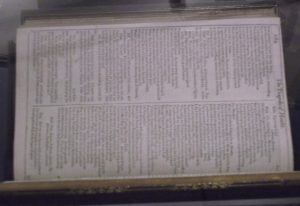A couple weeks ago I picked up a ticket for the 21st Annual Gambling Lecture, scheduled this year for the Mullins Center, and on this chilly and drizzly evening after work, I joined the crowd streaming in to the arena. Shortly after 6:30, Chancellor Subbaswamy welcomed us, then introduced Professor Léonce Ndikumana, Chair of the Economics Department, who first announced that the lecture is made possible by the Gamble Lecture Endowment, created in memory of Philip Gamble, who was an Economics professor at UMass from 1935-1971.
Professor Ndikumana then introduced a person who needs no introduction: Paul Krugman is a professor at CUNY, a scholar at the Storm Center, a policy advisor, and an opinion columnist at the New York Times; he also finds time to tweet to his 3.76 million Twitter followers. His work on international trade theory was cited by the Nobel Prize committee who awarded him the prize in Economics in 2008. In his work, he started with the tools of the trade, and then discovered the issues to which they apply. Krugman, we were told, is a “true intellectual” and is also known at the “Voice of the Left” and the “Explainer-in-Chief” for his efforts to bring understanding of abstruse economic concepts to the general public. He also does not shy away from confronting challenging views!
Krugman began his lecture by noting that conventional wisdom is not always based on facts. He then promised he would not denounce President Trump or predict the future. Instead, he wanted to spend his time “looking inward”. He asked himself, “Does economics make the world a better place?” After the 2008 financial crisis, he was a bit disappointed in his profession. The way he saw it: we did have a crisis; we recovered, but it took a long time. As the crisis unfolded, economists should have been asking, “Why were we so ill-prepared to deal with it?” and “Why have economic policies not been better”? Perhaps we are making progress on this front, insofar as the 2017 Nobel prize in Economics was awarded this month to Richard Thaler of Chicago for his work on non-rational players.
In his lecture this evening, Krugman said he would present three narratives about economics which arose out of the financial crisis: (1) Economics had nothing useful to say about it, (2) Nobody cares what economists do, and (3) Economics matters but only if economists are consistent and unified in their claims.
To the first narrative, he responded: Economists did know what to do to help get us out of the crisis, but policymakers didn’t follow the script. With respect to the second and third narratives, he argued that economics does matter, and in fact, economists did speak with a unified voice, but then opinions fragmented and the responses became ineffectual and beside the point.
Krugman believes economics started to go wrong when they forgot about John Hicks and his 1937 article, Mr Keynes and the Classics, which introduced the IS-LM (Investment-Savings, Liquidity-Money) model. Basically, IS-LM examines the relationship between real output, or GDP, and nominal interest rates. To explain this model, he showed two slides of different monetary supply curves. In the first graph, which depicts classic equilibrium conditions, a climbing GDP means that interest rates must rise as well. In contrast, the second graph depicts the liquidity trap, in which private demand is so low that the interest rate line remains essentially flat for longer than expected. Basically, what this means is that low interest rates change behavior. Certainly Ben Bernanke, chair of the Federal Reserve, understood this about monetary policy.
At this point, Krugman recommended that we become familiar with FRED, a massive database maintained by the St Louis Office of the Federal Reserve, available to both professional economists and the general public. If you look at the data on monetary base (bank reserves plus cash in circulation) in the years following the crisis — this number increased by 400%! But what did this signify? GDP didn’t increase dramatically; neither did consumer prices.
Now, what about government spending, the fiscal policy governments use in conjunction with monetary policy, in order to maintain a healthy national economy? First, it turns out that government spending, except on wars, doesn’t have that large of an effect because governments simply don’t spend that much. Second, in a social science like economics, it is hard to conduct experiments the way they are done in chemistry or physics.
But in Greece in 2009, the conditions were present for a natural experiment; in fact, Europe during 2009-2012 was a case study in fiscal austerity. Unfortunately, the government spending cuts did not work so well in Europe. So how much did government spending affect GDP here in the US? President Obama used a 1.5 multiplier, which turned out to be pretty much on the money (so to speak). Now what about the federal deficit due to government borrowing? As a percentage of GDP, it went up to 10% in 2009, which was unprecedented in peacetime. Again, this did not cause soaring interest rates and hyperinflation. In fact, basic macroeconomics worked pretty well after 2001. So when and how did it all go wrong?
In 1970, in the [Ned] Phelps volume, these economists made one prediction about persistently high inflation, which was based on perfect rationality. But it turns out that people are not perfectly rational actors. For example, in 1999 Truman Bewley examined why wages don’t fall during a recession and concluded that a simple sense of fairness prevents employers from cutting wages. This economic analysis of individual agents’ behaviors became known as “microeconomic foundations” and it took off in the 70s. Yale economist James Tobin in 1980 correctly understood these principles, but the profession was soon taken over by DSGE (Dynamic Stochastic General Equilibrium), guided by hyper-rationality. This was a mistake, Krugman believes, and we are only now entering an era of more nuanced thinking.
Krugman left us with some words of wisdom that he hopes will become “rules for reform”: (1) talk to real people about what they actually do (consult with colleagues in sociology and political science), (2) use microdata (which are detailed data), (3) use history, and (4) don’t obsess about rigor (because you can be precisely wrong). Let’s hope economics can do better in the next crisis which might come along.
To view a full recording of Paul Krugman’s Gambling lecture, please click on this link.
 I realized just this week that the folio would be on exhibit only for the rest of the month, so I resolved to make my way posthaste over to Amherst College on my lunch hour. Then I heard that a docent would give a talk about the Folio today at 2 pm, and I entered the event on my office calendar. Shortly before 2, a group of about fifty of us gathered just inside the front entrance to the Mead Art Museum (it happens to be Amherst Alumni Weekend), and right on time, Museum Educator Keely Sarr introduced herself and led us to the exhibit.
I realized just this week that the folio would be on exhibit only for the rest of the month, so I resolved to make my way posthaste over to Amherst College on my lunch hour. Then I heard that a docent would give a talk about the Folio today at 2 pm, and I entered the event on my office calendar. Shortly before 2, a group of about fifty of us gathered just inside the front entrance to the Mead Art Museum (it happens to be Amherst Alumni Weekend), and right on time, Museum Educator Keely Sarr introduced herself and led us to the exhibit. After Shakespeare’s death, John Heminge and Henry Condell, two friends and colleagues in the King’s Men, collected almost all of his plays, thirty-six total, for this edition, which also includes an engraved portrait of the playwright, mostly likely an authentic image of him. This was also the first collection to divide the plays into comedies, histories, and tragedies. The Second Folio was published about ten years later, and in the Third and Fourth Folios, additional plays were included, although most of these are not considered authentic by modern scholars.
After Shakespeare’s death, John Heminge and Henry Condell, two friends and colleagues in the King’s Men, collected almost all of his plays, thirty-six total, for this edition, which also includes an engraved portrait of the playwright, mostly likely an authentic image of him. This was also the first collection to divide the plays into comedies, histories, and tragedies. The Second Folio was published about ten years later, and in the Third and Fourth Folios, additional plays were included, although most of these are not considered authentic by modern scholars.